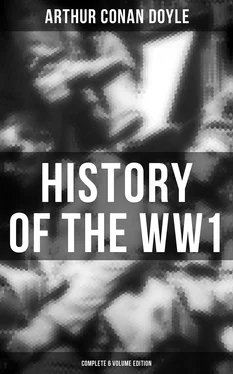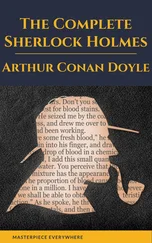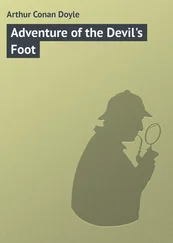There were two pieces of information in this fatal message, and each was disastrous. The first announced that instead of the two German corps whom he had reason to think were in front of him, there were four—the Third, Fourth, Seventh, and Fourth Reserve Corps—forming, with the second and fourth cavalry divisions, a force of nearly 200,000 men, while the Second Corps were bringing another 40,000 round his left flank from the direction of Tournai. The second item was even more serious. Instead of being buttressed up with French troops on either side of him, he learned that the Germans had burst the line of the Sambre, and that the French armies on his right were already in full retreat, while nothing substantial lay upon his left. It was a most perilous position. The British force lay exposed and unsupported amid converging foes who far outnumbered it in men and guns. What was the profit of one day of successful defence if the morrow would dawn upon a British Sedan? There was only one course of action, and Sir John decided upon it in the instant, bitter as the decision must have been. The Army must be extricated from the battle and fall back until it resumed touch with its Allies.
But it is no easy matter to disengage so large an army which is actually in action and hard-pressed by a numerous and enterprising enemy. The front was extensive and the lines of retreat were limited. That the operation was carried out in an orderly fashion is a testimony to the skill of the General, the talents of the commanders, and the discipline of the units. If it had been done at once and simultaneously it would certainly have been the signal for a vigorous German advance and a possible disaster. The positions were therefore held, though no efforts were made to retake those points where the enemy had effected a lodgment. There was no possible use in wasting troops in regaining positions which would in no case be held. As dusk fell, a dusk which was lightened by the glare of burning villages, some of the regiments began slowly to draw off to the rear. In the early morning of the 24th the definite order to retire was conveyed to the corps commanders, whilst immediate measures were taken to withdraw the impedimenta and to clear the roads.
Such, in its bare outlines, was the action of Mons upon August 23, interesting for its own sake, but more so as being the first clash between the British and German armies. One or two questions call for discussion before the narrative passes on. The most obvious of these is the question of the bridges. Why were they not blown up in the dangerous peninsula? Without having any special information upon the point, one might put forward the speculation that the reason why they were not at once blown up was that the whole of Joffre’s advance was an aggressive movement for the relief of Namur, and that the bridges were not destroyed because they would be used in a subsequent advance. It will always be a subject for speculation as to what would have occurred had the battle been fought to a finish. Considering the comparative merits of British and German infantry as shown in many a subsequent encounter, and allowing for the advantage that the defence has over the attack, it is probable that the odds might not have been too great and that Sir John French might have remained master of the field. That, however, is a matter of opinion. What is not a matter of opinion is that the other German armies to the east would have advanced on the heels of the retiring French, that they would have cut the British off from their Allies, and that they would have been hard put to it to reach the coast. Therefore, win or lose, the Army had no possible course open but to retire. The actual losses of the British were not more than three or four thousand, the greater part from the 8th, 9th, and 13th Brigades. There are no means as yet by which the German losses can be taken out from the general returns, but when one considers the repeated advances over the open and the constant breaking of the dense attacking formations, it is impossible that they should have been fewer than from seven to ten thousand men. Each army had for the first time an opportunity of forming a critical estimate of the other. German officers have admitted with soldierly frankness that the efficiency of the British came to them as a revelation, which is not surprising after the assurances that had been made to them. On the other hand, the British bore away a very clear conviction of the excellence of the German artillery and of the plodding bravery of the German infantry, together with a great reassurance as to their own capacity to hold their own at any reasonable odds.
After a night of flames and of uproar the day dawned, a day of great anxiety to the British commanders and of considerable pressure upon a portion of the troops. Sir John French had given instructions that the First Corps, which had been only slightly engaged the day before, should pretend to assume the offensive upon the extreme right wing in the direction of Binche, whilst the Second Corps began its retirement. The enemy was following up rapidly, however, along the whole length of the British line, both flanks of which were exposed. Shortly after dawn the evacuated positions had been occupied, and Mons itself was in the hands of the advancing Germans. The Second Corps began its retreat, helped by the feint which was carried out by General Haig upon the right, and by the bulk of the batteries of both corps, but the pursuit was vigorous and the shell-fire incessant. A shell from the rear is more intimidating than twenty in the front. Hamilton’s Third Division, including the 8th and 9th Brigades, who had done such hard work the day before, sustained the most severe losses, especially at Frameries, four miles south of Mons. The 2nd Royal Scots of the 8th Brigade about midnight had been attacked by a heavy German column which got so near that the swish of their feet through the long grass put the regiment on the alert. The attack was blown back by a volley at close quarters. The 9th Brigade (Shaw’s), which covered the retreat, was closely pressed from dawn by the pursuing Germans, and was subjected to a very heavy shell-fire. A barricade, erected in the village and manned by Captain Sandilands, of the Northumberlands, with his company, held up the German advance, and they were never permitted to reach the line nor to hustle the retirement. Butler’s 23rd Artillery Brigade helped with its fire. The chief losses in this skilful covering action fell upon the 1st Lincolns and upon the 1st Northumberland Fusiliers, each of which lost about 150 men, including Captain Rose, Lieutenants Bulbe, Welchman, and others. There was a stational ambulance in the village of Frameries, and a foreign nurse in its employ has left a vivid picture of the wounded British rushing in grimy and breathless to have their slighter wounds dressed and then running out, rifle in hand, to find their place in the firing line.
The remaining brigade of the Third Division, McCracken’s 7th Brigade, had detached one regiment, the 2nd Irish Rifles, upon the day before to reinforce the 8th Brigade, and this regiment had, as already mentioned, some severe fighting, holding back the German advance after the retirement from the Nimy Peninsula of the Middlesex and the Gordons. It did not find its way back to its brigade until the evening of the 24th. The brigade itself, during the first day of the retreat,, held a position near Ciply, to the south of Mons, where it was heavily attacked in the early morning, and in some danger as its flank was exposed. At ten o’clock it was ordered to retire via Genly towards Bavai, and it carried out this difficult movement in the face of a pushful enemy in perfect order, covered by the divisional artillery. The principal losses fell upon the 2nd South Lancashire Regiment, which came under heavy fire from German machine-guns posted upon slag-heaps. This regiment was very hard hit, losing several hundred men. The brigade faced round near Bavai and held off the pursuit.
Читать дальше












